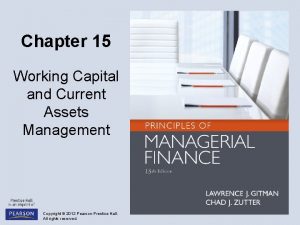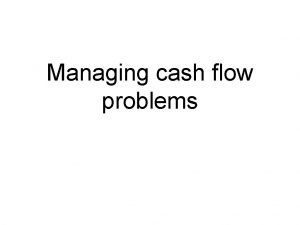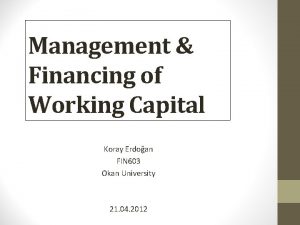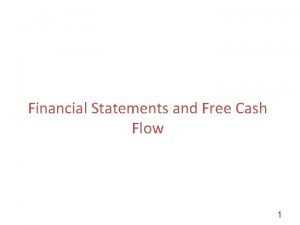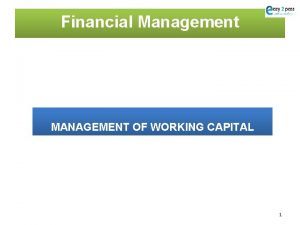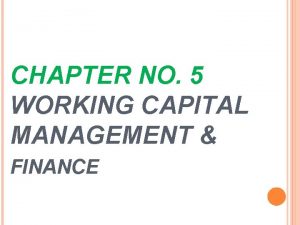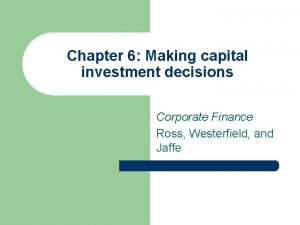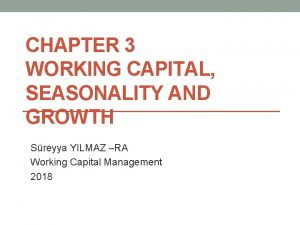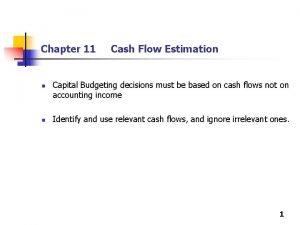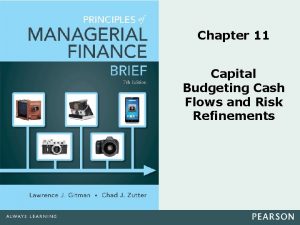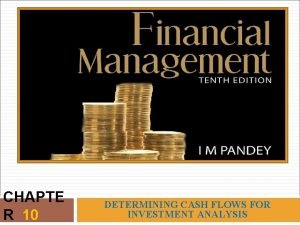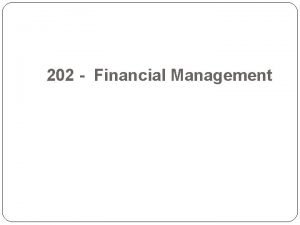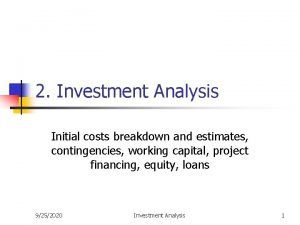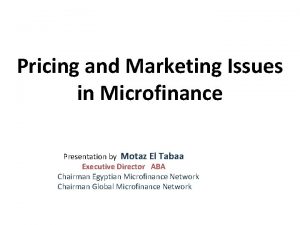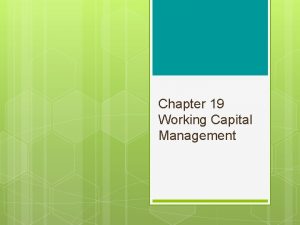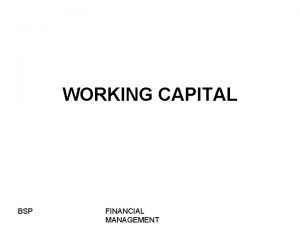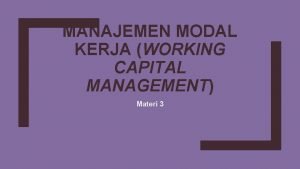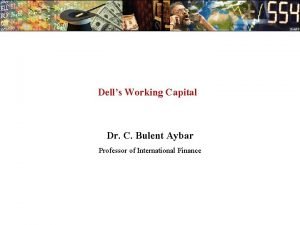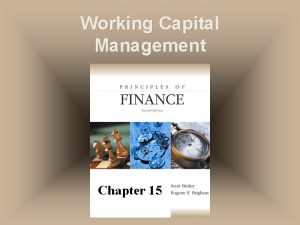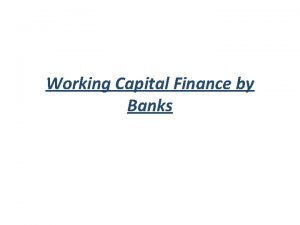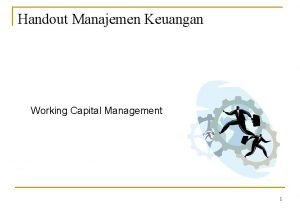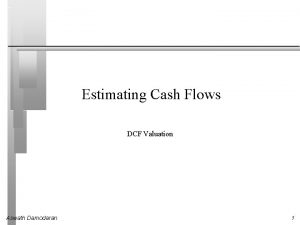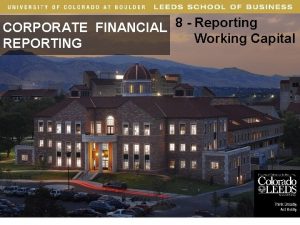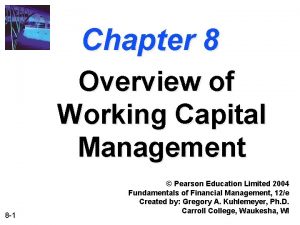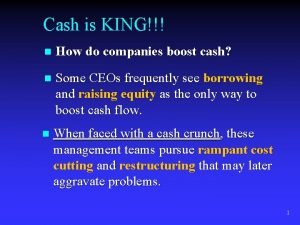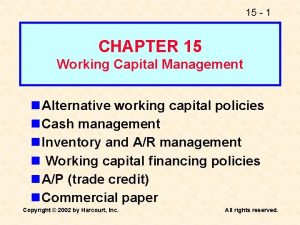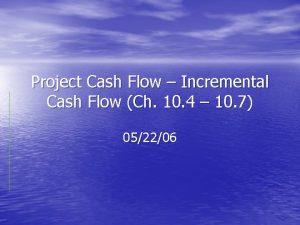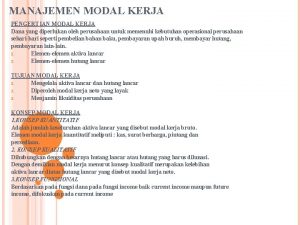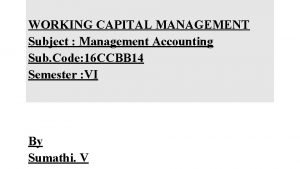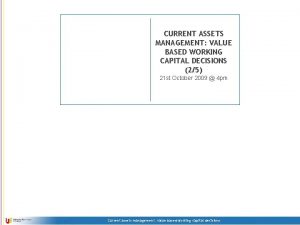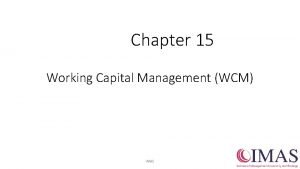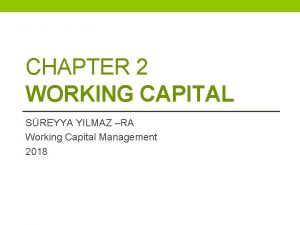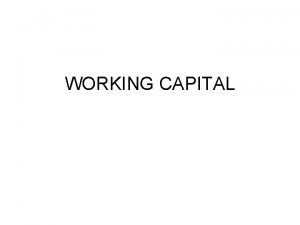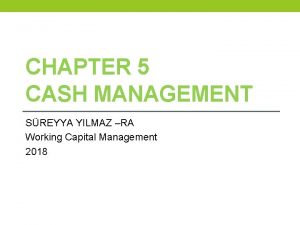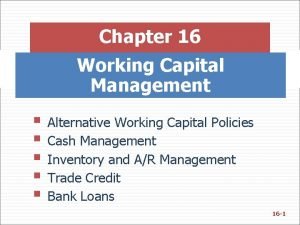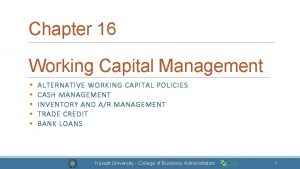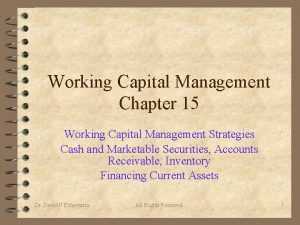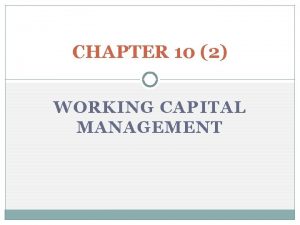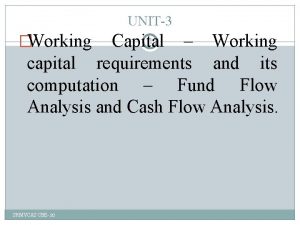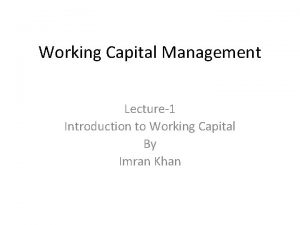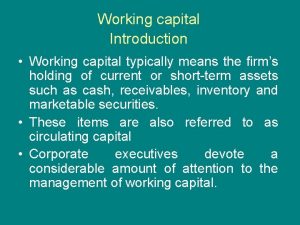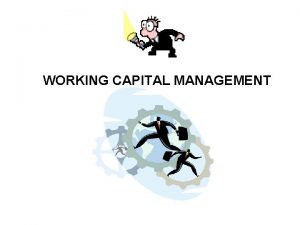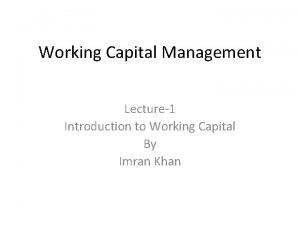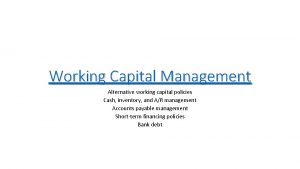CHAPTER 3 WORKING CAPITAL SEASONALITY AND GROWTH Sreyya

























































- Slides: 57

CHAPTER 3 WORKING CAPITAL, SEASONALITY AND GROWTH Süreyya YILMAZ –RA Working Capital Management 2018

What is the goal of this chapter? • The goal of this chapter is to help managers better understand the relation between a firm’s level of operating activity and working capital. • Firms tend to match financing maturity with their assets’ average life. This may lead the manager to finance shortterm operating assets with short-term debt.

THE EFFECTS OF SEASONALITY ON WORKING CAPITAL • Many industries are characterized by high seasonality. A seasonal business is one in which the majority of its trade occurs during a short period each year, or a business that experiences substantial changes in trading activity throughout the year.

What is the seasonal businesses? • Typical examples of seasonal businesses are those operating in the toy, tourism, and farming industries. For these businesses, it is essential to consider the impact of seasonality on the optimal level of working capital.

• One might expect the impact of seasonality on a firm’s operating activity to be such that, during the seasonal peak, the firm will require higher net investment in short term (current) assets and therefore higher working capital. This intuition, however, is part of the usual confusion.

• To see this, let’s consider the case of a firm whose main activity is the production and sale of toys (the toy industry is highly seasonal, with most of its sales concentrated between October and December). • What happens to the operating investment of the toy company during its seasonal peak?

• To answer this question, let’s look at each of the components of operating investment. • First, would it have more cash on its balance sheet? • Probably yes, since it is likely that the firm will face higher costs, such as production and marketing costs, during this time.

• Second, would the firm maintain higher levels of inventory in its balance sheet during the high season? • Presumably. The timing for the increase in inventory will depend on whether the firm selects a level production plan, which has a stable production rate, or a seasonal production plan, where production follows sales, but in either case average inventory will generally be higher during the peak season.

• Third, would the firm show greater account receivables during the peak? • Certainly. To help fund this higher operating investment, the firm will likely rely on more financing from suppliers. • Nevertheless, the firm’s net operating investment (FNOs) is likely to be higher during the peak season.

• Let’s go back to our basic concepts. Recall from Chapter 2 that FNOs are a short-term financing notion, whereas working capital is mostly connected to long-term finance. • This became obvious when we departed from the traditional accounting view of working capital (current assets minus current liabilities) and defined it as the difference between the permanent resources and the fixed (noncurrent) assets of the firm. We illustrate the connection between these concepts once more in Figure 1.


• Now, let’s use this new perspective to analyze what happens to working capital when the toy company enters its peak season. Will the manager be likely to finance the firm’s higher operating activity by increasing the working capital invested in the firm?

• Well, let’s think! Will the toy producer issue new long-term debt, or even equity, in order to finance increased activity during these three months? • Considering the related issuance, agency, and information costs, this would probably be an inefficient solution. • As a consequence (under the conditions we are exploring right now), the firm’s permanent resources will probably remain unchanged throughout the year. • What about the firm’s fixed assets (which affect working capital in the opposite direction)? • Will our toy producer be likely to, say, buy a new truck to adjust her distribution system according to the high season’s requirements?

• If she does, she would have to sell it back right after the high season ends to avoid an increase in idle capacity! • So this does not sound like a reasonable strategy either; that is, noncurrent assets are also likely to remain unchanged. So if permanent resources (long-term debt and equity) do not change, and noncurrent assets do not change, working capital, by construction, cannot change. • Ergo, seasonality should not affect decisions about the optimal level of working capital.

• The previous discussion sounds like a proof. However, it does not silence our perceptions, which tell us that something changes during seasonal peaks. If working capital does not change, what does? The answer: the firm’s FNOs.

Let’s imagine the summarized accounting information presented in Table 3. 1 • Now imagine that the firm’s high season arrives, during which time sales are 50% higher; assume operating ratios remain the same. What will the firm’s new FNOs be?


• We now have the question: if during its high season the firm increases its net operating investment (FNOs) but does not change its long term financing, how does the firm cover the gap? • we learned that, following the conceptual path, we should estimate FNOs as the difference between current assets and spontaneous resources, but we can also compute them as the sum of short-term debt and working capital. • This second expression makes it clear that the necessary net operating investment can be financed in two possible ways: working capital or short-term debt, where working capital is interpreted not simply as an investment decision but also as a financing strategy. In our previous graphs, we can see that whatever is not covered with working capital is financed with short-term debt.

• As the firm increases its activity level, its FNOs should follow the trend; however, because the higher level of activity is expected to last only temporarily, the firm has no incentive to change its working capital (which should change as a result of long-term changes in business activity). Graphically, we can summarize this conclusion as shown in Figure 3. 3.


• This discussion suggests that when a firm faces seasonality, it needs to analyze how to mix alternative sources of funding in order to cover financing needs that vary over time. To deepen our analysis, we now explore alternative financing strategies.

• Imagine that the firm’s manager wants to minimize raising long-term financing to avoid having to pay associated fees on funds that are not needed during long periods of lower activity. • In this case, the manager picks a level of working capital equal to the minimum monthly operating financial need and covers all peaks with short-term financing. Figure 3. 4 illustrates this choice.


• The graph shows that during the high season, the firm will increase its operating investment and, since working capital does not change, the increased investment will be financed using short term financial debt. • During the low season, in contrast, the firm covers all its financial needs with working capital and has zero shortterm financing.

• Under normal conditions, this strategy could be a cheap one: it minimizes the use of more expensive long-term capital. • However, in a more risky or uncertain market environment, this strategy could subject the firm to a high level of risk. • For example, if, when the firm’s financing requirement is high, a credit crunch or a similar crisis makes it impossible to raise short-term financing, this strategy could lead the firm to miss out on participating in the hot market and in turn to suffer a considerable loss or even bankruptcy.

• Now imagine that the manager decides to pursue the opposite strategy. That is, to avoid rushing in search of immediate financing for each peak, she chooses a high level of working capital covered by long-term finance. This extreme scenario is depicted in Figure 3. 5.


• Following this second strategy, the manager could sleep very confidently, knowing that all her potential operating financials needs will be covered. • However, her comfortable pillow is likely to be extremely expensive, with the firm not using its assets to their full potential. • During low season, there would be more funds than necessary within the firm which, being long-term loans or even equity, are likely to require a considerable return. • The idle funds could certainly be invested in short-term, but the return on such investments is generally low, particularly if one compares it with its associated cost.

• Moreover, this strategy also implies assuming some interest rate risk. Since the duration of assets would be, on average, shorter than the duration of liabilities, interest rate variation would break the balance among them. • For example, if the economy enters a recession, leading to lower interest rates, even though the value of both assets and liabilities would increase, the latter would do so more strongly, weakening the financial position of the firm.

Which of these strategies is the best one to follow? • It’s depends, among other things, on the business’s debt capacity and its access to debt. • A firm’s location is also likely to influence this decision: if the seasonal firm is in the United States, Germany, or similar countries (where financing opportunities are usually relatively easy to access), the optimal choice would probably require a lower investment in working capital (long-term operating finance) than if the same business were located in a developing country. • However, in general, the optimal strategy is not likely to be characterized by either of these extreme strategies, but rather is likely to lie somewhere in between. Such an intermediate strategy is depicted in Figure 3. 6.


• The trade-off between the goals of minimizing low-return investments (idle cash) and avoiding liquidity risk should guide the proper level of working capital selected. Given this choice, the portion of financial needs for operation that are not covered with working capital will be financed with short-term debt. • Thus, while a sound financial policy will count on longterm financing to partially cover varying financial needs, short-term debt should be optimally raised to finance seasonal cash shortages due to changes in operational investment.

• When firms fail to have a coherent working capital policy in the context of a developed capital market, a wise advisor would probably point that out and the firm would correct the problem, experiencing almost no frictions. • When the firm instead operates in an emerging economy, which, as we’ve noted, usually have low-quality capital markets (i. e. , capital is in short supply, market size and liquidity are an issue, and institutional failures are common), inappropriate financing of operating activities can lead the firm into financial distress.

FINANCING GROWTH • So far, we have considered the problem of a manager selecting the optimal level of working capital for the case of firms facing seasonality. • However, this optimal decision is potentially, indeed, most likely, dynamic: most firms not only observe seasonal variation in economic activity but also grow over time.

• The question we turn to here is whether a firm should adjust its working capital when it experiences not just seasonality but also a clearly defined trend (either positive or negative) in activity level.

• Imagine a firm that, without changing any commercial, production, or operational policy, is experiencing a sudden increase in sales (e. g. , consumers started going crazy about one of its key products). Since the investment in, say, receivables will be equal to number of days of customers’ credit ´ daily sales, the firm’s operational investment will certainly be higher. • However, the impact of growth on operational investment will be stressed if it results not only from an external phenomenon (such as fashion hits or general market growth) but also from the firm’s strategic decisions.

As an example • Consider a firm that used to allow customers to pay in 15 days, but that has extended the collection period to 20 days, there by attracting more customers and in turn increasing sales. For each dollar of sales, there would now be five extra days of account receivables waiting to be cashed in. There would also be more sales dollars to finance. • This represents a supplementary investment in customers equal to 5 days’ the previous daily volume + 20 days ´ the volume increase in daily sales. In this case, both the increase in the collection period and the higher level of sales would require higher investment in current assets, investment that would require additional financing. This type of strategy is depicted in Figure 3. 7.


• Given that the firm must increase its investment in current assets to implement its strategic growth policies, the firm has to choose between financing this investment with short-term debt or working capital. • But how should this decision be made? Is it optimal, as in the case of a seasonal firm, to maintain a given level of working capital and cover all additional financing requirements with short-term debt? • Let’s explore this option. If the firm decides to maintain its level of working capital, the situation would be as depicted in Figure 3. 8.


• As we can see from the figure, the gap between the financial needs for operation and the corresponding longterm financing (working capital) would increase over time. Ergo, the firm would need even greater access to credit (short-term debt), which is not always available particularly in the case of emerging markets. • As a consequence, the company will be able to take advantage of all possible growth opportunities only in those cases in which the current financial market climate makes it possible to access the necessary funds. This is a very risky strategy.

• Most firms would instead choose a level of working capital that moves in response not to seasonal sales variation, but to a well-defined trend in the level of economic activity (which is indicated with a dashed line in Figure 3. 8 ). The shape of the adjustment path will depend on firm and market characteristics. One possible scenario is shown in Figure 3. 9.


POSITIVE VERSUS NEGATIVE WORKING CAPITAL STRATEGIES AND GROWTH • Consider first the investment in current assets of airlines. These firms’ sales are typically made on the basis of cash or short-term credit card financing; on average, they have a collection period (i. e. , account receivables) of less than 15 days. Moreover, outstanding inventory also tends to be low (as is the case for most service businesses); let’s pick a 10 -day ratio. • Finally, especially in the case of large airlines, which enjoy market power, suppliers often provide between 20 and 30 days of financing. The FNOs of airlines are therefore close to zero or even negative, which implies that these firms are able to pursue a self-financing growth strategy.

• Next, consider businesses in which inventory of high turnover or perishable goods is normally delivered at highfrequency intervals (e. g. , on a daily basis). The use of automatic replenishment systems, together with the effective exercise of market power, allows these firms to maintain relatively low levels of inventory; let’s pick for our example a holding period of about seven days. • What about trade receivables? Even though some fraction of sales is made on credit, the regular collection period is fairly short, probably less than 10 days.

• Turning to financing from suppliers, given the volume and consequent market power characterizing some of these businesses (e. g. , Mc. Donalds), we can assume a pretty long payment period. • Taken together, and considering that these firms will likely have a few days’ cash on hand, we again have a class of firms that are likely to have zero or negative FNOs, that is, companies that are capable of self financing their growth. • Note that zero or negative FNOs may arise not just from patterns particular to a firm’s industry but also from a specific firm’s business strategy a strategy that may even break industry patterns.

• A classic example is the case of Dell’s strategy consists of providing online-based, customized sales, which translates into almost zero inventory and accounts receivable: • Dell’s customers place their order on the internet, together with their credit card information; only after payment information has been processed does the firm inform its suppliers to start building the required system. • This strategy, as has been widely documented, allowed Dell to grow steadily without requiring high investment in working capital.

• It is instructive at this point to stop to reflect again on the differences— and complementarities—between FNOs and working capital. In this section so far, we are not focusing attention on firms or industries that are distinguished for simply having negative working capital (although these firms would indeed have negative working capital). • Rather, we are pointing out that firms that have low required investment in current assets (because of industry patterns or a particular business strategy) and that are likely to rely on significant financing from suppliers experience negative FNOs.

• Moreover, we are saying that, under these conditions, a firm is likely to be able to self-finance its operations and hence would not need to search for financing (be it shortterm debt or working capital), regardless of whether the firm faces seasonality or pursues steady growth. Figure 3. 10 shows this graphically.


• Note that in the previous scenario, a firm’s working capital will not always be equal to its FNOs (as it appears in Figure 3. 10 ). Indeed, this would be the case only if shortterm debt were equal to zero. In contrast, if there is at least some short-term debt, working capital will be larger (in absolute value) than the FNOs. • Shifting gears, we now consider a totally different scenario, namely, one in which a firm has positive FNOs (a positive financing gap) and negative working capital. 10 This scenario is depicted in Figure 3. 11.


• In this case, the firm needs to actively finance its operation (FNOs are greater than zero), and it does so completely with short-term finance. Note that the short-term finance even covers part of the firm’s fixed investment. • In general, this is very risky: the firm doesn’t simply fail to finance long-term investment with long-term sources of funds (either debt or equity), but it sustains the whole operation (which, as we have observed, is not completely short term in real terms ) with short-term financing.

What could be potential reasons for doing this? • Perhaps the firm has a particular view about future business conditions, or more likely it has no other option (i. e. , it faces financing constraints). • Indeed, it is often the case in emerging economies that firms are unable to match asset and liability maturities due to market restrictions—they get the financing they can. We will go over these issues later, when we discuss working capital management in the context of emerging markets.

CONCLUSION • The punch line of this analysis is that, while revenues (cash flow) should be financed with short-term debt, profits (growth) should be financed with more permanent sources. • Put differently, while seasonality-related sales should be funded primarily through the use of short-term financing, growth should be funded by adjusting the level of working capital—with the exception of firms and/or industries that enjoy low required investment in current assets and high supplier financing, that is, negative FNOs and working capital.

• This distinction in optimal funding for seasonality and growth should have clear implications for a company’s financial planning. • In particular, failure to differentiate between seasonal fluctuations in economic activity and actual growth will cause the firm to either take suboptimal financing risks (financing with short-term debt investments that really call for long-term financing, resulting in the risk that some opportunities may not receive funding) or pay too high a required return on financial capital (financing short-term needs with long-term debt, resulting in idle funds upon which payments are due).

NEXT WEEK • Read chapter 4 Thank you for attendance Lovely week
 Working capital introduction
Working capital introduction Gold stock seasonality
Gold stock seasonality Hot working and cold working difference
Hot working and cold working difference Hot working
Hot working Differentiate between hot working and cold working
Differentiate between hot working and cold working Proses pengerjaan logam
Proses pengerjaan logam Myfinancelab solutions chapter 15
Myfinancelab solutions chapter 15 Growth is defined as an increase in
Growth is defined as an increase in Eudicot
Eudicot Primary growth and secondary growth in plants
Primary growth and secondary growth in plants Primary growth and secondary growth in plants
Primary growth and secondary growth in plants Working hard vs working smart
Working hard vs working smart Source of capital reserve
Source of capital reserve Multinational capital structure
Multinational capital structure Difference between capital reserve and reserve capital
Difference between capital reserve and reserve capital Variable capital examples
Variable capital examples Multinational cost of capital and capital structure
Multinational cost of capital and capital structure Operating cycle formula
Operating cycle formula Ideal working capital turnover ratio
Ideal working capital turnover ratio Insufficient cash flow
Insufficient cash flow Factors affecting working capital requirements
Factors affecting working capital requirements Fcf nopat
Fcf nopat What is working capital in financial management
What is working capital in financial management Net working capital cash
Net working capital cash Working capital investment example
Working capital investment example Negative working capital
Negative working capital Operating net working capital formula
Operating net working capital formula Wally's
Wally's How to find change in working capital
How to find change in working capital Incremental cash flows definition
Incremental cash flows definition What is working capital in financial management
What is working capital in financial management Working capital breakdown
Working capital breakdown Working capital life cycle
Working capital life cycle Working capital ratio
Working capital ratio Working capital
Working capital Materi working capital management
Materi working capital management Trade working capital
Trade working capital Dell's working capital
Dell's working capital Working capital managemetn
Working capital managemetn Working capital terminology
Working capital terminology Working capital finance by commercial banks
Working capital finance by commercial banks Working capital management
Working capital management Dcf aswath
Dcf aswath Working capital reporting
Working capital reporting Hedging approach of working capital
Hedging approach of working capital Boost working capital
Boost working capital Working capital financing policy
Working capital financing policy Relevant cash flow
Relevant cash flow Modal kerja bruto adalah
Modal kerja bruto adalah Modal kerja bruto adalah
Modal kerja bruto adalah Sub working capital
Sub working capital Working capital decisions
Working capital decisions Drags and pulls on liquidity
Drags and pulls on liquidity Carothers equation
Carothers equation Geometric growth vs exponential growth
Geometric growth vs exponential growth Neoclassical growth theory vs. endogenous growth theory
Neoclassical growth theory vs. endogenous growth theory Organic growth vs inorganic growth
Organic growth vs inorganic growth Basle ii
Basle ii






